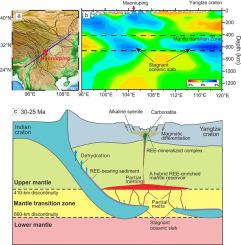Ore Geology Reviews ( IF 3.2 ) Pub Date : 2021-04-24 , DOI: 10.1016/j.oregeorev.2021.104193 Qiang Weng , Wu-Bin Yang , He-Cai Niu , Ning-Bo Li , Pan Qu , Qiang Shan , Guo-Qiang Fan , Zhao-Yong Jiang , Ze-Yang Zhang , Ao Li , Xiao-Chen Zhao

|
The Maoniuping giant rare earth element deposit is genetically related to a Cenozoic alkaline syenite–carbonatite complex. However, the origin of the alkaline complex and the genesis of the Maoniuping deposit are still unclear. In this study, the origin of the Maoniuping complex was constrained through B–Sr–Nd–Pb isotopic data for fresh/unaltered alkaline syenites. Our results indicate that the Maoniuping alkaline syenite has arc-like trace element patterns with elevated initial 87Sr/86Sr (0.706040–0.706541), 206Pb/204Pb (18.00–18.32), 207Pb/204Pb (15.53–15.60), and 208Pb/204Pb (38.25–38.78) ratios, and relatively low εNd(t) values (–4.92 to –2.66), suggesting derivation by partial melting of fertile mantle source. It also has higher B contents (1.06–7.65 ppm) and heavier δ11B values (−5.38‰ to − 2.46‰) than the upper mantle, indicating modification of the mantle source by interaction with carbonatitic melts/fluids derived from marine sediments and altered oceanic crust within the subducting Indian slab. Our results, together with recently acquired seismic tomographic data, indicate that hybridisation in the mantle source was likely induced by subduction input of marine sediments to the mantle transition zone. Boron isotopes provide a novel indicator of the deep recycling of subducted crustal materials in the sources of alkaline magmas.











































 京公网安备 11010802027423号
京公网安备 11010802027423号